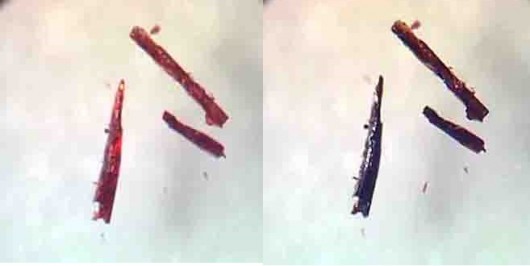Oxygen absorbing material may allow us to breathe underwater
October 4, 2014

Just a few grains of the newly synthesized material could allow us to stay underwater without scuba tanks ... or yoga (Photo: Shutterstock)
Using specially synthesized crystalline materials, scientists from the University of Southern Denmark have created a substance that is able to absorb and store oxygen in such high concentrations that just one bucketful is enough to remove all of the oxygen in a room. The substance is also able to release the stored oxygen in a controlled manner when it is needed, so just a few grains could replace the need for divers to carry bulky scuba tanks.
The key component of the new material is the element cobalt, which is bound in a specially designed organic molecule. In standard form – and depending on the available oxygen content, the ambient temperature, and the barometric pressure – the absorption of oxygen by the material from its surroundings may take anything from seconds to days.
"An important aspect of this new material is that it does not react irreversibly with oxygen – even though it absorbs oxygen in a so-called selective chemisorptive process," said Professor Christine McKenzie from the University of Southern Denmark. "The material is both a sensor, and a container for oxygen – we can use it to bind, store, and transport oxygen – like a solid artificial hemoglobin."

Varying the constituent structure of the material can also bind and release oxygen at different rates. This means it could be used to regulate oxygen supply in fuel cells or create devices like face masks that use layers of the material to provide pure oxygen to a person directly from the air, without the need of other equipment.
Even more interestingly, the material may also be configured in a device that could absorb oxygen directly from water and allow a diver to stay submerged for long periods of time, without the need for bulky air tanks.
"This could be valuable for lung patients who today must carry heavy oxygen tanks with them," explains Professor McKenzie. "But also divers may one day be able to leave the oxygen tanks at home and instead get oxygen from this material as it 'filters' and concentrates oxygen from surrounding air or water. A few grains contain enough oxygen for one breath, and as the material can absorb oxygen from the water around the diver and supply the diver with it, the diver will not need to bring more than these few grains."
Using x-ray diffraction techniques to peer inside the atomic arrangement of the material when it had been filled with oxygen, the scientists realized that once the oxygen has been absorbed it can be stored in the material until it is released by heating the material gently or subjecting it to a vacuum.
"We see release of oxygen when we heat up the material, and we have also seen it when we apply vacuum," said Professor McKenzie. "We are now wondering if light can also be used as a trigger for the material to release oxygen – this has prospects in the growing field of artificial photosynthesis."
There's no word as yet on any possible commercial production or public availability of the material.
The research was published in the journal of the Royal Society of Chemistry, Chemical Science.
Source: University of Southern Denmark.
http://www.gizmag.com/crystalline-material-absorb-oxygen-denmark/34064